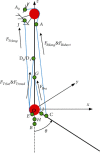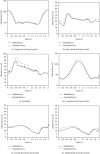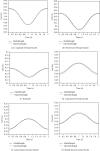An Improved EMG-Driven Neuromusculoskeletal Model for Elbow Joint Muscle Torque Estimation
- PMID: 34754328
- PMCID: PMC8572603
- DOI: 10.1155/2021/1985741
An Improved EMG-Driven Neuromusculoskeletal Model for Elbow Joint Muscle Torque Estimation
Abstract
The accurate measurement of human joint torque is one of the research hotspots in the field of biomechanics. However, due to the complexity of human structure and muscle coordination in the process of movement, it is difficult to measure the torque of human joints in vivo directly. Based on the traditional elbow double-muscle musculoskeletal model, an improved elbow neuromusculoskeletal model is proposed to predict elbow muscle torque in this paper. The number of muscles in the improved model is more complete, and the geometric model is more in line with the physiological structure of the elbow. The simulation results show that the prediction results of the model are more accurate than those of the traditional double-muscle model. Compared with the elbow muscle torque simulated by OpenSim software, the Pearson correlation coefficient of the two shows a very strong correlation. One-way analysis of variance (ANOVA) showed no significant difference, indicating that the improved elbow neuromusculoskeletal model established in this paper can well predict elbow muscle torque.
Copyright © 2021 Bingshan Hu et al.
Conflict of interest statement
The authors declare no conflict of interest.
Figures












Similar articles
-
Incorporating ultrasound-measured musculotendon parameters to subject-specific EMG-driven model to simulate voluntary elbow flexion for persons after stroke.Clin Biomech (Bristol). 2009 Jan;24(1):101-9. doi: 10.1016/j.clinbiomech.2008.08.008. Epub 2008 Nov 13. Clin Biomech (Bristol). 2009. PMID: 19012998
-
Feasibility of using EMG driven neuromusculoskeletal model for prediction of dynamic movement of the elbow.J Electromyogr Kinesiol. 2005 Feb;15(1):12-26. doi: 10.1016/j.jelekin.2004.06.007. J Electromyogr Kinesiol. 2005. PMID: 15642650
-
Cerebellar ataxia: abnormal control of interaction torques across multiple joints.J Neurophysiol. 1996 Jul;76(1):492-509. doi: 10.1152/jn.1996.76.1.492. J Neurophysiol. 1996. PMID: 8836239
-
A Linear Approach to Optimize an EMG-Driven Neuromusculoskeletal Model for Movement Intention Detection in Myo-Control: A Case Study on Shoulder and Elbow Joints.Front Neurorobot. 2018 Nov 13;12:74. doi: 10.3389/fnbot.2018.00074. eCollection 2018. Front Neurorobot. 2018. PMID: 30483090 Free PMC article.
-
Characteristics of synergic relations during isometric contractions of human elbow muscles.J Neurophysiol. 1986 Nov;56(5):1225-41. doi: 10.1152/jn.1986.56.5.1225. J Neurophysiol. 1986. PMID: 3794767
Cited by
-
Elbow Joint Stiffness Functional Scales Based on Hill's Muscle Model and Genetic Optimization.Sensors (Basel). 2023 Feb 3;23(3):1709. doi: 10.3390/s23031709. Sensors (Basel). 2023. PMID: 36772750 Free PMC article.
References
-
- Xu D., Wu Q., Zhu Y. Development of a sEMG-based joint torque estimation strategy using Hill-type muscle model and neural network. Journal of Medical and Biological Engineering . 2021;41(1):34–44. doi: 10.1007/s40846-020-00539-2. - DOI
-
- Liu H., Tao J., Lyu P., Tian F. Human-robot cooperative control based on sEMG for the upper limb exoskeleton robot. Robotics and Autonomous Systems . 2020;125:p. 103350. doi: 10.1016/j.robot.2019.103350. - DOI
-
- Zhang J., Zhang B., Zhang N., Wang C., Chen Y. A novel robust event‐triggered fault tolerant automatic steering control approach of autonomous land vehicles under in‐vehicle network delay. International Journal of Robust and Nonlinear Control . 2021;31(7):2436–2464. doi: 10.1002/rnc.5393. - DOI
-
- Ao D., Song R., Gao J. W. Movement performance of human-robot cooperation control based on EMG-driven hill-type and proportional models for an ankle power-assist exoskeleton robot. IEEE Transactions on Neural Systems and Rehabilitation Engineering . 2017;25(8):1125–1134. doi: 10.1109/TNSRE.2016.2583464. - DOI - PubMed
-
- Mma A., Xuan Z., Ling W., et al. Human lower extremity joint moment prediction: a wavelet neural network approach. Expert Systems with Applications . 2014;41(9):4422–4433.
LinkOut - more resources
Full Text Sources

